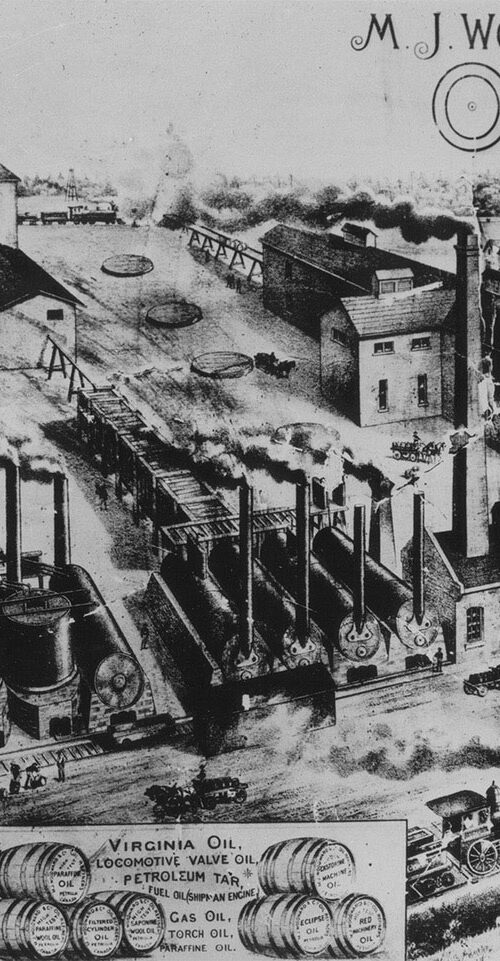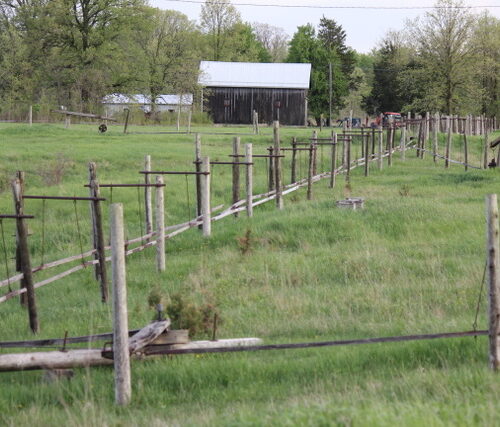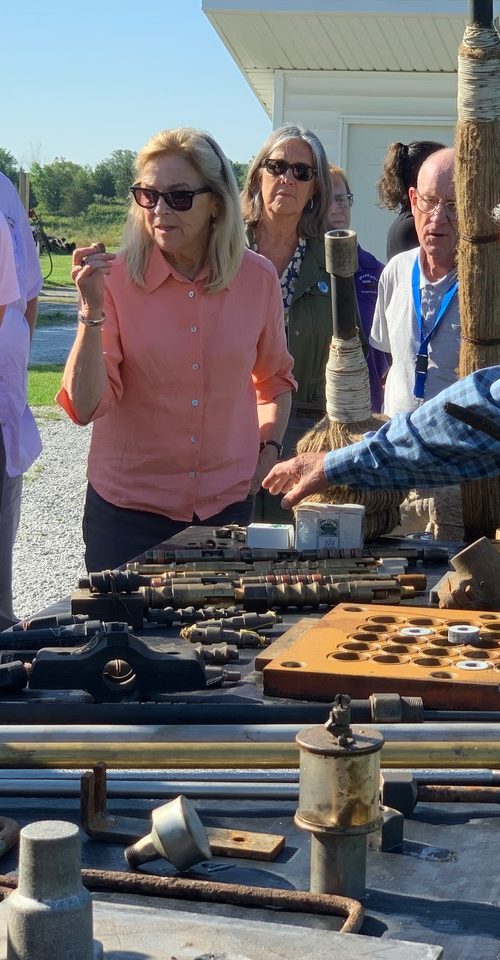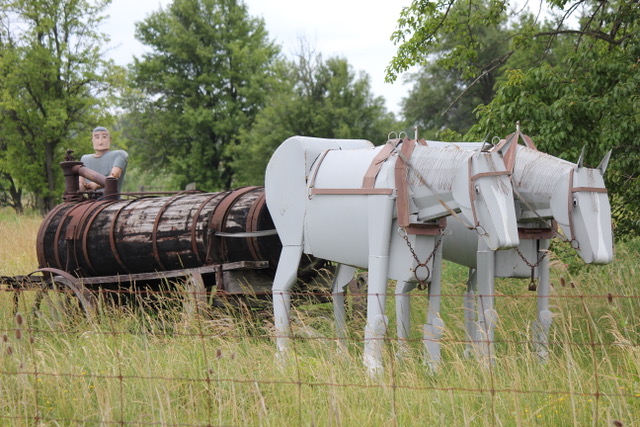The Audio Driving Tour includes a stop at the Fairbank Oil barn mural, first painted in 1981 when Fairbank Oil celebrated its 120th year anniversary. This year marks 163 years since John Henry Fairbank produced his first oil well in Oil Springs.
Touring Oil Springs Gets Even Better
Summer is the ideal time for touring around. Pack up the car with all those visiting friends and relatives and head out for an adventure.
This summer touring of Oil Springs where the North American oil industry began just got better. The Audio Driving Tour got a boost from technology this year. Now, if someone in your vehicle has a cell phone, you can pick up the app at the Oil Museum of Canada and get the audio narrative right to your car and take the tour at your own pace. More than just a narrative of the historic oil fields, the app also delivers video clips, historic photos and sidebars of info for the curious.
The app is available with admission to the oil museum and staff are on hand to show how to install it and use it. The new tech is possible through a Creative County Grant and the Oil Museum of Canada Foundation. Fairbank Oil, the Village of Oil Springs, the foundation and the oil museum worked together to make it a reality.
And that’s not all. The group is also gradually updating the 10 interpretive signs scattered throughout the village and on the Old Mill Trail. The signs tell the stories of the buildings rooted in history and other interesting spots. Yes, Oil Springs had a flour mill and it ran on crude oil! Other fun facts: The Plank Road to Sarnia, still used today, was built way back in 1862 to overcome the impossible clay road. VanTuyl and Fairbank Hardware of Petrolia ran a highly successful satellite store in Oil Springs for more than 40 years. There is so much to find out.
To celebrate the County of Lambton’s 175th anniversary, Doors Open will be held Saturday, September 28 so stay tuned for the happenings at The Oil Museum of Canada. In another special county celebration held in June, 27 Heritage Champions from throughout the county were honoured. Among them were Charlie Fairbank and Pat McGee of Fairbank Oil. Nice!
We have stories!
Use the tabs above to find more stories on our history, technology, Driving Tour, all blogs, and more! Scroll down to learn about Touring Fairbank Oil Fields
What’s New?
 The Early Refining Of Black Gold In Lambton County
The Early Refining Of Black Gold In Lambton County
 The Jerker Line Hits 160th Anniversary
The Jerker Line Hits 160th Anniversary
The Jerker Line Hits 160th Anniversary
 International Heritage Group Tours Oil Springs and Studies Lambton Oil History
International Heritage Group Tours Oil Springs and Studies Lambton Oil History
International Heritage Group Tours Oil Springs and Studies Lambton Oil History
Touring Fairbank Oil Fields
The Driving Tour
Take a leisurely drive from the Oil Museum of Canada and you can see the oil fields in action and our life-sized metal sculptures of oilmen working. The sculptures have been made by Murray Watson and they are arranged like actors in a play showing how the work was done in earlier days.
If you’d like to hear the driving tour’s audio narrative, begin by touring the Oil Museum of Canada and you can get a map with the radio frequencies for each stop.
This a tour best seen at a slow pace. The jerker line moves at 11-times per minute, the same pace as relaxed breathing. Take a few moments to watch it. Some find it almost hypnotic and soothing.
To simply tour without the audio, click here for a full description of each stop.
Fairbank Oil Fields by Numbers
Number of oil wells now operating: 350
Number of oil wells operating in 1974: 70
Number of years since most oil wells were drilled here: 120 +
Number of acres: 650
Number of barrels of oil pumped here annually: 24,000
Number of barrels J.H. Fairbank pumped when he was the largest oil producer in Canada in the 1800s: 24,000
Number of barrels the Black and Matheson flowing well produced in Oil Springs in one day in 1862: 6,000
Year that Lambton County started sending its 500 Foreign Drillers to 86 countries around the world to open new oilfields: 1873
Population of Oil Springs on the February 1861 census: 54
Population of Oil Springs in 1865: 4,000
Population of Oil Springs in 2016: 648
Number of Munro Honey bees living at Fairbank Oil: 500,000
Number of acres farmed with crops here today: 100
Number of years that sheep have been raised here: 80
Ratio of oil wells to sheep: 3 to 1
Ranking of the abundance of flora and fauna biodiversity of Fairbank Oil in Lambton County: 2nd
Ranking of the abundance of flora and fauna biodiversity of Walpole Island in Lambton County: 1st
Number of butterfly species identified here: 29
Number of grassland bird species identified here: 43
Year Imperial Oil was formed in London, Ontario: 1880
Number of years Fairbank Oil has been shipping crude to Imperial Oil so far: 139
Number of years ago that glaciers covered this part of the country: 10,000 +
Number of years ago that the oil here was formed by plants and sea creatures: 350 million
Number of litres in a barrel of oil: 154
Number of Imperial gallons in a barrel of oil: 35
Number of American gallons in a barrel of oil: 42
Hours each day that the wells are pumping: 24
Average price of a barrel of crude in 2018: $69.52 U.S.
Average price of a barrel of crude in 1972 before the oil embargo on the Middle East: $1.82 U.S.
Average price of a barrel of crude in 1974 after the oil embargo: $11.00 U.S.
Number of wells the big Fairbank & Shannon rig had pumped in 1906: 212
Horsepower need for each of the six power rigs: 5
Number of km. of wooden jerker line on Fairbank Oil: 12
Number of km. if the depth of all the wells at Fairbank Oil were laid end to end: 37 km
Number of metres beneath the ground the oil is here: 133
Ratio of water to oil when it comes up to surface here: 50 to 3
Cost of installing the first disposal well in 1991: $250,000
Number of individual metal sculptures of real people here: 22
Number of donkeys: 1
Current number of domestic geese wandering the property: 7
Number of deer wandering the oilfields and woods: Countless
What else is here?
Lots! In all of Lambton County, only Walpole Island has greater biodiversity than Fairbank Oil Fields.
As the county is farmed more intensively and urban development grows, the forests, wetlands and meadows have largely disappeared. This makes Fairbank Oil Fields very important to preserving these habitats.
There are two key reasons the biodiversity is so huge here. One is that Black Creek meanders through the northern and western sections of our land. The second reason is that our various landscapes are large enough to be brimming with life.
Within our 600 acres of woodlands, wetlands and grasslands, we have sheep, geese, deer, wild turkeys, owls, beavers, possums, turtles, frogs, butterflies, more than 80 species of birds, plus we have 500,000 Munro Honey bees and a donkey named Jack.
And in total, we have 315 species of plants. A number of the trees and plants here are rare for Ontario or rare for Lambton County.

